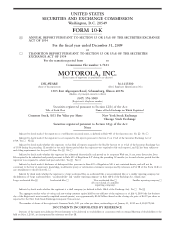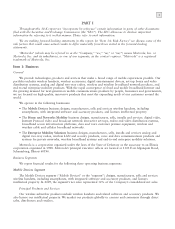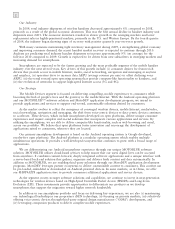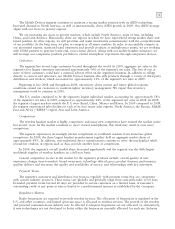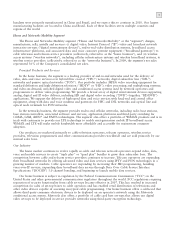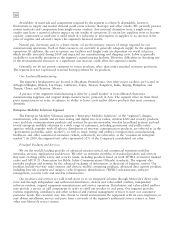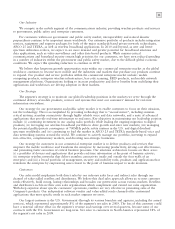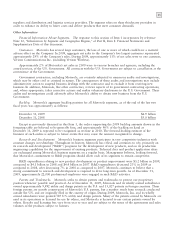Motorola 2009 Annual Report Download - page 16
Download and view the complete annual report
Please find page 16 of the 2009 Motorola annual report below. You can navigate through the pages in the report by either clicking on the pages listed below, or by using the keyword search tool below to find specific information within the annual report.
8
In our home business, we compete worldwide in the market for digital entertainment devices and cable and
wireline infrastructure equipment for broadband networks. Our largest competitor is Cisco. Based on 2009
annual sales, we are the leading provider of digital cable and IPTV set-tops worldwide. Our digital entertainment
devices and infrastructure equipment compete with products from a number of different companies, including:
(i) those that develop and sell products that are distributed by direct broadcast satellite service providers through
retail channels; (ii) those that develop, manufacture and sell products of their own design; and (iii) those that
license technology from us or other competitors.
Traditionally, cable service providers leased set-tops to their customers with an integrated conditional access
content security system. In 2007, FCC regulations requiring the separation of security functionality from set-tops
became effective. In meeting this requirement, we provide security modules to cable operators for use with both
our own and third-party set-tops, as well as in consumer products designed to accept them. The initial
implementation limited consumer products to broadcast-delivered channels including premium services. Several
major cable operators are working to support full two-way security interface architecture that allows retail
customers access to all programming available on the operator’s network without the need for a set-top box. A
few television and video device manufacturers have begun shipping or are developing such devices. If they achieve
a meaningful volume of sales they could negatively impact our sales of set-tops to cable providers.
We also compete worldwide in the market for broadband data and voice products. We believe that we are a
leading provider of cable modems worldwide, competing with several consumer electronic companies and original
design manufacturers worldwide. Our largest competitors for cable and telco broadband data and voice devices
include Technicolor (formerly Thomson), Huawei and Arris.
In the wireless networks market, there is widespread competition from numerous competitors, ranging from
some of the world’s largest diversified companies to foreign telecommunications equipment vendors to many
small, specialized firms. Ericsson is the market leader, followed by the Nokia-Siemens joint venture, followed by
Alcatel-Lucent, Huawei and Motorola, along with other vendors with similar market share. We believe we are a
leading provider of WiMAX technologies.
The segment’s networks business is confronting several factors that could impact its business, including,
continuing consolidation among competitor telecommunications equipment providers, consolidation among
customers, the potential impact of global economic conditions, and vendor financing by competitors as customers
continue to look to vendors as an additional source of financing.
Payment Terms
Payment terms vary worldwide, depending on the arrangement. In North America, payment is generally due
30 to 60 days from the invoice date. In regions outside of North America, terms vary widely but are typically
limited to no more than 90 days. Contracts for wireless networks typically include implementation milestones,
such as delivery, installation and system acceptance, which generally take 30 to 180 days to complete. Invoicing
the customer is dependent on the completion of the milestone.
As required for competitive reasons, extended payment terms are provided to customers from time-to-time on
a limited basis. The segment’s payment terms are consistent with industry practice, as many of our contracts are
awarded through a competitive bid process. When required for competitive reasons, we may provide long-term
financing in connection with equipment purchases. Financing may cover all or a portion of the purchase price.
Regulatory Matters
Many of our products are subject to regulation by the FCC in the United States and other communications
regulatory agencies around the world. In addition, our customers, and their networks into which our products are
incorporated, are subject to government regulation. Government regulatory policies affecting either the willingness
or the ability of cable and telecom operators, wireless operators and wireline operators to offer certain services,
or the terms on which these operators offer the services and conduct their business, may have a material adverse
effect on the segment’s results. Motorola has developed products using trunking and data communications
technologies to enhance spectral efficiencies. The growth and results of the wireless communications industry may
be affected by regulations impacting access to allocated spectrum for wireless communications users, especially in
urban areas where the spectrum is heavily used.



